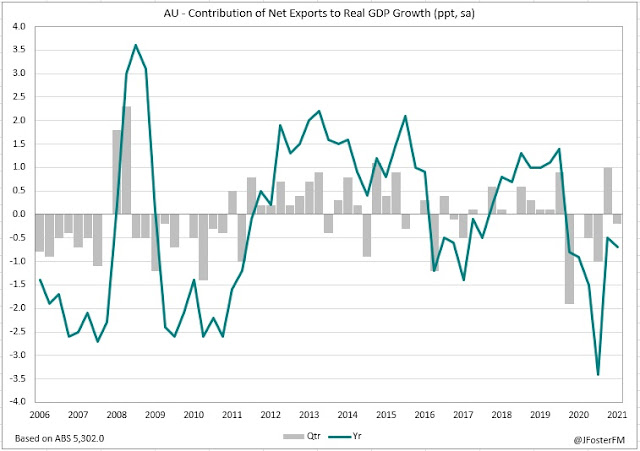Australia's current account surplus narrowed in the December quarter as export earnings were weighed by a decline in the iron ore price. Net exports are only a modest headwind to growth in the quarter.
- Australia's current account surplus narrowed by $9.3bn to $12.7bn (vs $14.3bn expected). Q3's surplus was revised down from $23.9bn to $22bn.
- The trade surplus narrowed by $6.4bn in the quarter to $31bn. Export earnings declined by 1.1% while import spending lifted by 4.9%.
- The income deficit widened by $2.8bn as returns to foreign investors advanced, coming in at $17.5bn in Q4.
- ABS reported that net exports will subtract 0.2ppt from GDP growth in Q4.
Balance of Payments — Q4 | The details
Australia's current account surplus remained elevated in Q4 despite pulling back to $12.7bn (around 2% of GDP) from $22bn (around 4% of GDP) in the previous quarter. This was driven by a narrowing in the quarterly trade surplus, from $37.4bn to $31bn. Import spending lifted by 4.9%q/q to $96.6bn, with higher prices due to supply chain pressures the driving factor. Export earnings declined by 1.1% in the quarter to $107.8bn, weighed by a lower iron ore price and softer offshore demand.
In volume terms, export volumes fell by 1.5%q/q, reversing the previous quarter's rise. Exports were 12.8% below their pre-pandemic level. Declines were seen in both goods (-1.1%) and services (-4.6%) trade. The weakness in goods exports was driven by non-rural goods (-2.6%) as resources exports contracted in the quarter (-1.5%) and are also lower through the year (-3.5%). Although iron ore exports lifted slightly in Q4 (0.7%), this was more than offset by falls in other commodities: coal -4.9%, LNG -5.3% and metals -13.5%. Trade in rural exports continued to advance, reaching a new record high in the quarter as demand offshore for domestic produce remained strong. Services exports contracted by 4.6%q/q to be down 47% on its pre-pandemic level, hugely affected by the restrictions on travel into Australia.
Import volumes were down 0.9% in the quarter and were 8.6% below pre-pandemic levels. Imports had fallen by 2.8% in the lockdown-affected Q3, indicating pressures in global supply chains remained a constraint. Goods imports fell by 0.4%, with consumption (-2.6%) and capital goods (-3.9%) contracting. Constraints in vehicle production amid semi-conductor shortages continued to hold back vehicle imports (-10.3%), weighing on consumption goods (charts below). Capital goods were weighed by machinery and industrial equipment (-7.3%), also affected by semi-conductor shortages.
Although supply chain issues remained a headwind for imports, some improvement was seen in intermediate goods, rebounded from a weak Q3 with a 4% rise. Services imports continued to contract (-4.8%) amid the overseas travel ban and were 59% down on pre-pandemic levels.
With exports (-1.5%) contracting by more than imports (-0.9%) in Q4, net exports will weigh on quarterly GDP. However, the 0.2ppt deduction expected by the ABS was significantly lower than the 1ppt drag expected by markets ahead of today's release.
Balance of Payments — Q4 | Insights
A retracement in the iron ore price from elevated levels pulled Australia's current account surplus back to around 2% of GDP in Q4. Weaker offshore demand for Australia's resources has weighed on exports. Imports are rebounding from the pandemic recession but were held back over the second half of the year (-3.6%) due to the Delta lockdowns and supply chain constraints.
---
In the day's other release, the ABS reported the contribution to quarterly GDP from public demand will be broadly neutral in Q4.
ABS Chart








